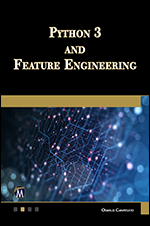Excel with Python: Performing Advanced Operations
Python
| Intermediate
- 17 videos | 1h 29m 33s
- Includes Assessment
- Earns a Badge
Learners can explore complex operations in Microsoft Excel workbooks, including the use of conditional formatting, named ranges, and merged cells, in this 17-video course. Microsoft Excel is the best prototyping tool for data analysis, an interactive functional programming environment, and a forerunner of Python. Begin by exploring how Python and its ecosystem of libraries are fast emerging as a popular choice for easy spreadsheet automation. Then observe the formatting, alignment, and other aesthetics in Python. You will work with the Python library openpyxl; examine data analysis, the use of pivot tables, and the locking of cell references by using the $ operator; and learn how to perform complex data analysis operations using pivot tables, sorting and filtering, and formulae with both absolute and relative cell references to enable efficient copy paste. You will learn to control the workbook appearance using conditional formatting and styles. Finally, this course demonstrates how to leverage the Python Pandas library to read a spreadsheet, to group and analyze data.
WHAT YOU WILL LEARN
-
Discover the key concepts covered in this courseApply styling elements to control the display of data in cellsApply sophisticated styles and alignments to format cell contentsUse number formats to represent currencies and add comma separatorsApply formatting that varies based on the value contained in a cellChoose from different in-built icon sets and rules to control cell formatting at a granular levelInsert images into microsoft excel files and control their size and locationInsert formulae into excel workbooksUse openpyxl to programmatically construct formulae in workbooks
-
Use the $ operator to convert relative cell references into absolute onesUse openpyxl to construct both absolute and relative cell referencesUse vlookup to lookup specific values from a range in excelAssign names to groups of cells and use those names in formulae to enhance readabilityUse excel pivot tables to dynamically analyze and group dataUse pandas to read data from microsoft excel and perform pivoting operationsUse pandas to perform multi-level indexing and access individual row values as well as index valuesSummarize the key concepts in this course
IN THIS COURSE
-
2m 12s
-
6m 57sIn this video, you will learn how to apply styling elements to control the way data is displayed in cells. FREE ACCESS
-
3. Working with Borders and Colors5m 9sTo format cell contents with sophisticated styles and alignments, find out how to apply them. FREE ACCESS
-
4. Applying Number Formats8m 4sLearn how to use number formats to represent currencies and add commas as separators. FREE ACCESS
-
5. Applying Conditional Formatting4m 31sDuring this video, you will learn how to apply formatting that varies based on the value contained in a cell. FREE ACCESS
-
6. Using Advanced Conditional Formatting4m 49sIn this video, you will learn how to choose from different in-built icon sets and rules to control cell formatting at a more granular level. FREE ACCESS
-
7. Working with Images3m 5sIn this video, you will insert images into Microsoft Excel files and control their size and position. FREE ACCESS
-
8. Working with Formulae6m 56sLearn how to insert formulas into Excel workbooks. FREE ACCESS
-
9. More Operations Using Formulae3m 29sLearn how to use openpyxl to programmatically construct formulas in workbooks. FREE ACCESS
-
10. Using Absolute and Relative Cell References5m 52sLearn how to use the $ operator to convert relative cell references into absolute references. FREE ACCESS
-
11. Programmatically Constructing Absolute References5m 28sIn this video, you will use openpyxl to construct both absolute and relative cell references. FREE ACCESS
-
12. Using VLOOKUP6m 46sFind out how to use VLOOKUP to look up specific values from a range in Excel. FREE ACCESS
-
13. Working with Named Ranges6m 8sTo make your formulas more readable, learn how to assign names to groups of cells. FREE ACCESS
-
14. Working with Pivot Tables5m 42sIn this video, you will learn how to use Excel pivot tables to dynamically analyze and group data. FREE ACCESS
-
15. Using Pandas for Pivoting7m 48sIn this video, you will learn how to use Pandas to read data from Microsoft Excel and perform pivoting operations. FREE ACCESS
-
16. Leveraging Multi-level Indexing in Pandas5m 10sIn this video, find out how to use Pandas to perform multi-level indexing and access individual row values as well as index values. FREE ACCESS
-
17. Course Summary1m 27s
EARN A DIGITAL BADGE WHEN YOU COMPLETE THIS COURSE
Skillsoft is providing you the opportunity to earn a digital badge upon successful completion on some of our courses, which can be shared on any social network or business platform.
Digital badges are yours to keep, forever.






